Pictures You Cant See the Same Way Again
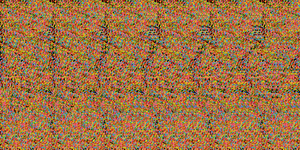
A random dot autostereogram encoding a 3D scene of a shark, which can exist seen with proper viewing technique (![]() ). Click on thumbnail to come across full-size image.
). Click on thumbnail to come across full-size image.

A like random dot autostereogram with the encoding of the 3D scene accomplished by changes in movement parallax instead of binocular parallax.

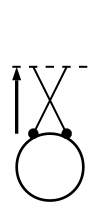
Cross-eyed vergence (![]() ).[1] Pointer indicates accommodation.
).[1] Pointer indicates accommodation.
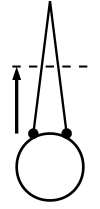
Wall-eyed ("parallel") convergence (![]() ).[1]
).[1]
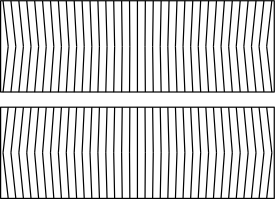
The top and lesser images produce a paring or projection depending on whether viewed with cross- (![]() ) or wall- (
) or wall- (![]() ) eyed vergence.
) eyed vergence.
An autostereogram is a single-image stereogram (SIS), designed to create the visual illusion of a iii-dimensional (3D) scene from a two-dimensional paradigm. About people with normal binocular vision are capable of seeing the depth in autostereograms, but to exercise so they must overcome the normally automatic coordination betwixt accommodation (focus of the optics) and horizontal vergence (angle of the eyes). The illusion is one of depth perception and involves stereopsis: depth perception arising from the different perspective each heart has of a 3-dimensional scene, called binocular parallax.
About 5% of people have disordered binocular vision that prevents them from seeing the depth in autostereograms or in conventional stereograms viewed through a stereoscope. To illustrate the depth for such people, the second prototype has had the binocular parallax replaced by motion parallax: the alteration in the position of points in the scene at unlike distances from a viewer's eyes equally the viewer'due south head moves. That is, this is a wiggle stereogram.
The simplest type of autostereogram consists of horizontally repeating patterns (often split images) and is known as a wallpaper autostereogram. When viewed with proper vergence, the repeating patterns appear to float in a higher place or below the background. The well-known Magic Eye books feature some other type of autostereogram called a random dot autostereogram, like to the first example, to a higher place. In this type of autostereogram, every pixel in the image is computed from a pattern strip and a depth map. A hidden 3D scene emerges when the image is viewed with the right vergence.
Autostereograms are similar to normal stereograms except they are viewed without a stereoscope. A stereoscope presents 2d images of the same object from slightly different angles to the left centre and the right heart, assuasive us to reconstruct the original object via binocular disparity. When viewed with the proper vergence, an autostereogram does the aforementioned, the binocular disparity existing in adjacent parts of the repeating 2D patterns.
There are two ways an autostereogram can exist viewed: wall-eyed and cantankerous-eyed.[a] Most autostereograms (including those in this commodity) are designed to be viewed in merely one way, which is ordinarily wall-eyed. Wall-eyed viewing requires that the two optics adopt a relatively parallel bending, while cross-eyed viewing requires a relatively convergent angle. An epitome designed for wall-eyed viewing if viewed correctly will appear to pop out of the background, whereas if viewed cross-eyed it volition instead appear every bit a cut-out behind the background and may be difficult to bring entirely into focus.[b]
History [edit]
In 1593, Giambattista della Porta viewed one page of a book with ane centre and another page with the other middle. He was able to read one of the pages, the other being invisible, and switch "the visual virtue" to read the other folio, the first becoming invisible.[2] This is an early case of dissociating vergence from accommodation—a necessary ability for seeing autostereograms. However, Porta saw competition between images viewed by the two optics, binocular rivalry.
Information technology was not until 1838 that the Charles Wheatstone published an case of cooperation between the images in the 2 eyes: stereopsis (binocular depth perception). He explained that the depth arose from differences in the horizontal positions of the images in the two eyes. He supported his explanation by showing apartment, 2-dimensional pictures with such horizontal differences, stereograms, separately to the left and right eyes through a stereoscope he invented based on mirrors. From such pairs of flat images, people experienced the illusion of depth.[3] [4]
In 1844, David Brewster discovered the "wallpaper effect".[v] He noticed that when he stared at repeated patterns in wallpapers while varying his vergence, he could see them either behind the wall (with wall-eyed vergence) or in front of the wall (with cross-eyed vergence).[6] This is the basis of wallpaper-style autostereograms.[3]
In 1939 Boris Kompaneysky[vii] published the first, random-dot stereogram containing a hand-fatigued image of the confront of Venus,[8] intended to be viewed with a device.
In 1959, Bela Julesz,[9] [10] vision scientist, psychologist, and MacArthur Swain, invented random dot stereograms while working at Bell Laboratories on recognizing camouflaged objects from aerial pictures taken by spy planes. At the time, many vision scientists causeless that stereopsis required prior assay of visible contours of images in each eye, merely Julesz showed it occurs with images with no such visible contours in each of the eyes. The contours of the depth object go visible only after stereopsis had processed the differences in the horizontal positions of dots in the two eyes' images.[11] [12]
Japanese designer Masayuki Ito, following Julesz, created a single image stereogram in 1970 and Swiss painter Alfons Schilling created a handmade single-image stereogram in 1974,[8] after creating more than one viewer and coming together with Julesz.[13] Having experience with stereo imaging in holography, lenticular photography, and vectography, he developed a random-dot method based on closely spaced vertical lines in parallax.[xiv]
In 1979, Christopher Tyler of Smith-Kettlewell Plant, a student of Julesz and a visual psychophysicist, combined the theories behind single-image wallpaper stereograms and random-dot stereograms (the work of Julesz and Schilling) to create the first blackness-and-white random-dot autostereogram with the help of computer programmer Maureen Clarke using Apple Ii and BASIC.[15] Stork and Rocca published the first scholarly paper and provided software for generating random-dot stereograms.[16] This blazon of autostereogram allows a person to encounter 3D shapes from a single 2nd prototype without the aid of optical equipment.[17] [18] In 1991 estimator developer Tom Baccei and artist Cheri Smith created the start color random-dot autostereograms, later marketed every bit Magic Eye.[xix]
A computer procedure that extracts back the hidden geometry out of an autostereogram image was described by Ron Kimmel.[20] In addition to classical stereo it adds smoothness as an important assumption in the surface reconstruction.
In the late 90's many children's magazines featured autostereograms. Even gaming magazines like Nintendo Power had a section specifically made for these illusions.
How they work [edit]
Simple wallpaper [edit]

This is an example of a wallpaper with repeated horizontal patterns. Each pattern is repeated exactly every 140 pixels. The illusion of the pictures lying on a flat surface (a plane) farther back is created by the brain. Not-repeating patterns such as arrows and words, on the other hand, appear on the airplane where this text lies.
Stereopsis, or stereo vision, is the visual blending of two similar but not identical images into 1, with resulting visual perception of solidity and depth.[21] [22] In the human brain, stereopsis results from complex mechanisms that form a three-dimensional impression by matching each point (or set of points) in one eye's view with the equivalent point (or set of points) in the other eye's view. Using binocular disparity, the encephalon derives the points' positions in the otherwise inscrutable z-centrality (depth).
When the brain is presented with a repeating pattern like wallpaper, it has difficulty matching the two eyes' views accurately. By looking at a horizontally repeating blueprint, but converging the 2 eyes at a point behind the pattern, information technology is possible to play a joke on the encephalon into matching i element of the pattern, equally seen past the left middle, with another (similar looking) element, abreast the showtime, as seen by the right center. With the typical wall-eyed viewing, this gives the illusion of a plane bearing the same pattern simply located backside the existent wall. The distance at which this plane lies behind the wall depends only on the spacing betwixt identical elements.[23]
Autostereograms apply this dependence of depth on spacing to create iii-dimensional images. If, over some area of the picture, the pattern is repeated at smaller distances, that expanse will appear closer than the background airplane. If the distance of repeats is longer over some expanse, and then that area will appear more distant (like a hole in the airplane).

This autostereogram displays patterns on three different planes past repeating the patterns at unlike spacings. (![]() )
)
People who have never been able to perceive 3D shapes subconscious within an autostereogram notice information technology difficult to understand remarks such as, "the 3D image will just pop out of the groundwork, later on you stare at the motion picture long enough", or "the 3D objects will just emerge from the background". It helps to illustrate how 3D images "emerge" from the background from a 2d viewer'south perspective. If the virtual 3D objects reconstructed by the autostereogram viewer's brain were real objects, a second viewer observing the scene from the side would see these objects floating in the air above the background image.
The 3D furnishings in the case autostereogram are created by repeating the tiger rider icons every 140 pixels on the background airplane, the shark rider icons every 130 pixels on the second plane, and the tiger icons every 120 pixels on the highest aeroplane. The closer a ready of icons are packed horizontally, the higher they are lifted from the background airplane. This repeat altitude is referred to as the depth or z-axis value of a particular pattern in the autostereogram. The depth value is also known as Z-buffer value.
| This picture illustrates how 3D shapes from an autostereogram "emerge" from the background plane, when the autostereogram is viewed with proper middle deviation. | Depth or z-axis values are proportional to pixel shifts in the autostereogram. |
The encephalon is capable of almost instantly matching hundreds of patterns repeated at different intervals in gild to recreate correct depth information for each blueprint. An autostereogram may comprise some fifty tigers of varying size, repeated at different intervals against a complex, repeated background. Still, despite the apparent chaotic arrangement of patterns, the brain is able to place every tiger icon at its proper depth.[ neutrality is disputed]
| The brain can identify every tiger icon on its proper depth plane. ( | This image illustrates how an autostereogram is perceived by a viewer |
Depth maps [edit]
| Depth map example autostereogram: Patterns in this autostereogram announced at dissimilar depth across each row. | ||||
| Depth map greyscale instance autostereogram: The black, greyness and white colors in the background represent a depth map showing changes in depth across row. | Pattern epitome | |||
Autostereograms where patterns in a item row are repeated horizontally with the same spacing can exist read either cross-eyed or wall-eyed. In such autostereograms, both types of reading volition produce similar depth interpretation, with the exception that the cantankerous-eyed reading reverses the depth (images that once popped out are now pushed in).
Withal, icons in a row exercise not demand to be arranged at identical intervals. An autostereogram with varying intervals between icons across a row presents these icons at different depth planes to the viewer. The depth for each icon is computed from the distance between it and its neighbour at the left. These types of autostereograms are designed to be read in only one way, either cross-eyed or wall-eyed. All autostereograms in this commodity are encoded for wall-eyed viewing, unless specifically marked otherwise. An autostereogram encoded for wall-eyed viewing will produce inverse patterns when viewed cross-eyed, and vice versa.[b] Most Magic Centre pictures are too designed for wall-eyed viewing.
The wall-eyed depth map example autostereogram to the right encodes 3 planes across the x-centrality. The groundwork plane is on the left side of the picture. The highest plane is shown on the right side of the picture. In that location is a narrow eye airplane in the middle of the 10-axis. Starting with a background airplane where icons are spaced at 140 pixels, one can enhance a particular icon by shifting it a sure number of pixels to the left. For instance, the middle airplane is created past shifting an icon x pixels to the left, effectively creating a spacing consisting of 130 pixels. The brain does not rely on intelligible icons which stand for objects or concepts. In this autostereogram, patterns become smaller and smaller downwards the y-axis, until they look like random dots. The brain is still able to match these random dot patterns.
The distance relationship between any pixel and its analogue in the equivalent pattern to the left can exist expressed in a depth map. A depth map is but a grayscale prototype which represents the distance between a pixel and its left counterpart using a grayscale value between black and white.[18] By convention, the closer the distance is, the brighter the colour becomes.
Using this convention, a grayscale depth map for the example autostereogram tin can be created with black, grey and white representing shifts of 0 pixels, x pixels and 20 pixels, respectively equally shown in the greyscale example autostereogram. A depth map is the key to creation of random-dot autostereograms.
Random-dot [edit]
| | |
A computer program can have a depth map and an accompanying blueprint image to produce an autostereogram. The program tiles the pattern image horizontally to cover an area whose size is identical to the depth map. Conceptually, at every pixel in the output image, the program looks up the grayscale value of the equivalent pixel in the depth map image, and uses this value to determine the corporeality of horizontal shift required for the pixel.
1 way to attain this is to make the programme scan every line in the output image pixel-past-pixel from left to correct. It seeds the first series of pixels in a row from the pattern prototype. Then it consults the depth map to retrieve appropriate shift values for subsequent pixels. For every pixel, it subtracts the shift from the width of the pattern image to arrive at a repeat interval. It uses this repeat interval to look up the color of the counterpart pixel to the left and uses its color as the new pixel's ain color.[23]
| Three raised rectangles appear on unlike depth planes in this autostereogram. ( | Every pixel in an autostereogram obeys the distance interval specified past the depth map. |
Dissimilar the simple depth planes created by elementary wallpaper autostereograms, subtle changes in spacing specified past the depth map can create the illusion of shine gradients in altitude. This is possible because the grayscale depth map allows individual pixels to exist placed on one of 2 n depth planes, where north is the number of $.25 used by each pixel in the depth map. In practice, the total number of depth planes is adamant by the number of pixels used for the width of the pattern paradigm. Each grayscale value must be translated into pixel space in social club to shift pixels in the final autostereogram. As a outcome, the number of depth planes must be smaller than the pattern width.
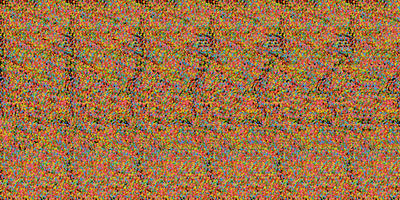
This random dot autostereogram features a raised shark with fine slope on a flat background. (![]() )
)

The revelation of the shark.
The fine-tuned slope requires a design epitome more complex than standard repeating-pattern wallpaper, so typically a pattern consisting of repeated random dots is used. When the autostereogram is viewed with proper viewing technique, a hidden 3D scene emerges. Autostereograms of this form are known as Random Dot Autostereograms.
Smooth gradients can also exist accomplished with an intelligible design, assuming that the design is complex enough and does not have big, horizontal, monotonic patches. A big expanse painted with monotonic color without modify in hue and effulgence does non lend itself to pixel shifting, as the upshot of the horizontal shift is identical to the original patch. The following depth map of a shark with smooth gradient produces a perfectly readable autostereogram, even though the 2D paradigm contains small monotonic areas; the brain is able to recognize these small-scale gaps and make full in the blanks (illusory contours). While intelligible, repeated patterns are used instead of random dots, this blazon of autostereogram is all the same known by many every bit a Random Dot Autostereogram, because information technology is created using the same process.
| The shark effigy in this depth map is drawn with a smooth gradient. | The 3D shark in this random-dot autostereogram has a shine, circular shape due to the utilise of depth map with smooth slope. ( |
Animated [edit]

When a series of autostereograms are shown one after some other, in the aforementioned mode moving pictures are shown, the encephalon perceives an animated autostereogram. If all autostereograms in the animation are produced using the same background pattern, information technology is often possible to see faint outlines of parts of the moving 3D object in the 2d autostereogram image without wall-eyed viewing; the constantly shifting pixels of the moving object can be clearly distinguished from the static background plane. To eliminate this side upshot, animated autostereograms oftentimes use shifting background in order to disguise the moving parts.
When a regular repeating pattern is viewed on a CRT monitor as if information technology were a wallpaper autostereogram, it is usually possible to see depth ripples. This can also be seen in the background to a static, random-dot autostereogram. These are acquired past the sideways shifts in the image due to small-scale changes in the deflection sensitivity (linearity) of the line scan, which and so go interpreted as depth. This consequence is especially credible at the left manus border of the screen where the scan speed is nevertheless settling afterwards the flyback stage. On a TFT LCD, which functions differently, this does non occur and the effect is not nowadays. Higher quality CRT displays too have meliorate linearity and showroom less or none of this effect.
Mechanisms for viewing [edit]
Much advice exists about seeing the intended 3-dimensional epitome in an autostereogram. While some people may chop-chop meet the 3D image in an autostereogram with little effort, others must acquire to train their optics to decouple eye convergence from lens focusing.
Not every person can see the 3D illusion in autostereograms. Because autostereograms are constructed based on stereo vision, persons with a variety of visual impairments, even those affecting only one center, are unable to meet the three-dimensional images.
People with amblyopia (also known every bit lazy eye) are unable to run across the 3-dimensional images. Children with poor or dysfunctional eyesight during a critical menstruation in childhood may grow up stereoblind, as their brains are not stimulated by stereo images during the critical menses. If such a vision problem is not corrected in early babyhood, the harm becomes permanent and the adult will never be able to see autostereograms.[3] [c] Information technology is estimated that some one percent to 5 per centum of the population is afflicted past amblyopia.[25]
3D perception [edit]
Depth perception results from many monocular and binocular visual clues. For objects relatively shut to the eyes, binocular vision plays an of import role in depth perception. Binocular vision allows the brain to create a single Cyclopean prototype and to attach a depth level to each bespeak in information technology.[11]
| The two eyes converge on the object of attention. | The brain creates a Cyclopean paradigm from the two images received by the ii eyes. | The brain gives each point in the Cyclopean prototype a depth value, represented hither by a grayscale depth map. |
The brain uses coordinate shift (likewise known equally parallax) of matched objects to identify depth of these objects.[23] The depth level of each signal in the combined image can be represented past a grayscale pixel on a 2D image, for the benefit of the reader. The closer a point appears to the encephalon, the brighter it is painted. Thus, the fashion the encephalon perceives depth using binocular vision tin can be captured by a depth map (Cyclopean epitome) painted based on coordinate shift.

The eye adjusts its internal lens to go a clear, focused paradigm

The ii optics converge to point to the aforementioned object
The eye operates similar a photographic photographic camera. It has an adjustable iris which tin open (or close) to permit more (or less) light to enter the centre. As with whatsoever photographic camera except pinhole cameras, it needs to focus low-cal rays entering through the iris (discontinuity in a camera) then that they focus on a single point on the retina in gild to produce a precipitous epitome. The heart achieves this goal by adjusting a lens behind the cornea to refract calorie-free appropriately.
When a person stares at an object, the two eyeballs rotate sideways to point to the object, so that the object appears at the middle of the paradigm formed on each eye's retina. In society to wait at a nearby object, the two eyeballs rotate towards each other and then that their eyesight can converge on the object. This is referred to equally cross-eyed viewing. To meet a faraway object, the two eyeballs diverge to get nearly parallel to each other. This is known as wall-eyed viewing, where the convergence angle is much smaller than that in cross-eyed viewing.[a]
Stereo-vision based on parallax allows the brain to calculate depths of objects relative to the point of convergence. It is the convergence bending that gives the encephalon the accented reference depth value for the point of convergence from which absolute depths of all other objects can exist inferred.
Imitation 3D perception [edit]

Decoupling focus from convergence tricks the brain into seeing 3D images in a 2d autostereogram
The optics ordinarily focus and converge at the aforementioned distance in a process known as accommodative convergence. That is, when looking at a faraway object, the brain automatically flattens the lenses and rotates the ii eyeballs for wall-eyed viewing. Information technology is possible to train the encephalon to decouple these two operations. This decoupling has no useful purpose in everyday life, considering information technology prevents the brain from interpreting objects in a coherent manner. To see a man-fabricated pic such as an autostereogram where patterns are repeated horizontally, withal, decoupling of focusing from convergence is crucial.[three]
By focusing the lenses on a nearby autostereogram where patterns are repeated and by converging the eyeballs at a distant point behind the autostereogram epitome, one tin play tricks the encephalon into seeing 3D images. If the patterns received by the ii eyes are similar enough, the encephalon will consider these two patterns a match and treat them as coming from the same imaginary object. This type of visualization is known every bit wall-eyed viewing, because the eyeballs adopt a wall-eyed convergence on a distant plane, even though the autostereogram image is really closer to the eyes.[23] Because the two eyeballs converge on a aeroplane farther abroad, the perceived location of the imaginary object is behind the autostereogram. The imaginary object as well appears bigger than the patterns on the autostereogram because of foreshortening.
The following autostereogram shows iii rows of repeated patterns. Each pattern is repeated at a unlike interval to place information technology on a different depth plane. The ii non-repeating lines can be used to verify correct wall-eyed viewing. When the autostereogram is correctly interpreted by the brain using wall-eyed viewing, and one stares at the dolphin in the center of the visual field, the brain should see two sets of flickering lines, as a result of binocular rivalry.[11]
| The two black lines in this Autostereogram assistance viewers establish proper wall-eyed viewing, encounter right. | When the brain manages to establish proper wall-eyed viewing, it will see two sets of lines. |

Top-row cubes announced farther away and bigger. (![]() )
)
While in that location are half dozen dolphin patterns in the autostereogram, the brain should encounter 7 "apparent" dolphins on the plane of the autostereogram. This is a side upshot of the pairing of like patterns by the brain. There are five pairs of dolphin patterns in this image. This allows the encephalon to create five apparent dolphins. The leftmost pattern and the rightmost pattern past themselves have no partner, merely the brain tries to assimilate these two patterns onto the established depth plane of adjacent dolphins despite binocular rivalry. Every bit a consequence, there are seven credible dolphins, with the leftmost and the rightmost ones appearing with a slight flicker, not dissimilar to the two sets of flickering lines observed when 1 stares at the 4th apparent dolphin.
Because of foreshortening, the difference in convergence needed to run into repeated patterns on different planes causes the brain to attribute different sizes to patterns with identical 2D sizes. In the autostereogram of three rows of cubes, while all cubes have the aforementioned physical second dimensions, the ones on the top row appear bigger, because they are perceived every bit further away than the cubes on the second and tertiary rows.
Viewing techniques [edit]

Butterflies, cross-eyed autostereogram (![]() )
)
If i has two eyes, adequately good for you eyesight, and no neurological conditions which prevent the perception of depth, and so i is capable of learning to see the images within autostereograms.[ citation needed ] "Similar learning to ride a bicycle or to swim, some pick it up immediately, while others accept a harder time."[26]
As with a photographic photographic camera, it is easier to brand the eye focus on an object when there is intense ambient light. With intense lighting, the middle can constrict the educatee, nonetheless allow enough light to reach the retina. The more the eye resembles a pinhole photographic camera, the less it depends on focusing through the lens.[d] In other words, the degree of decoupling between focusing and convergence needed to visualize an autostereogram is reduced. This places less strain on the brain. Therefore, it may exist easier for first-time autostereogram viewers to "encounter" their first 3D images if they attempt this feat with bright lighting.
Vergence command is important in beingness able to come across 3D images. Thus it may assist to concentrate on converging/diverging the two optics to shift images that accomplish the two optics, instead of trying to see a clear, focused image. Although the lens adjusts reflexively in order to produce clear, focused images, voluntary command over this procedure is possible.[27] The viewer alternates instead between converging and diverging the two eyes, in the process seeing "double images" typically seen when i is boozer or otherwise intoxicated. Eventually the brain will successfully lucifer a pair of patterns reported by the two eyes and lock onto this particular degree of convergence. The brain will besides adjust heart lenses to get a clear epitome of the matched pair. One time this is done, the images around the matched patterns quickly get clear as the brain matches additional patterns using roughly the same degree of convergence.

A blazon of wallpaper autostereogram featuring 3D objects instead of apartment patterns (![]() )
)

The bottom office of this autostereogram is costless of 3D images. Information technology is easier to flim-flam the brain into matching pairs of patterns in this area. (![]() )
)
When one moves one's attention from i depth aeroplane to some other (for instance, from the top row of the chessboard to the bottom row), the two optics need to adjust their convergence to match the new repeating interval of patterns. If the level of alter in convergence is likewise high during this shift, sometimes the brain can lose the difficult-earned decoupling between focusing and convergence. For a first-fourth dimension viewer, therefore, it may be easier to see the autostereogram, if the two eyes rehearse the convergence exercise on an autostereogram where the depth of patterns across a particular row remains constant.
In a random dot autostereogram, the 3D image is usually shown in the center of the autostereogram against a groundwork depth plane (encounter the shark autostereogram). It may assist to establish proper convergence starting time past staring at either the superlative or the bottom of the autostereogram, where patterns are commonly repeated at a abiding interval. Once the brain locks onto the background depth aeroplane, information technology has a reference convergence degree from which it tin and then match patterns at different depth levels in the centre of the image.
The bulk of autostereograms, including those in this article, are designed for divergent (wall-eyed) viewing. One fashion to help the encephalon concentrate on divergence instead of focusing is to hold the picture in forepart of the face up, with the nose touching the picture. With the picture so shut to their eyes, most people cannot focus on the picture. The brain may give up trying to movement eye muscles in gild to get a articulate picture. If 1 slowly pulls back the picture abroad from the face, while refraining from focusing or rotating eyes, at some point the brain will lock onto a pair of patterns when the distance betwixt them matches the electric current convergence degree of the ii eyeballs.[17]
Another way is to stare at an object behind the picture in an try to constitute proper divergence, while keeping part of the eyesight fixed on the picture show to convince the brain to focus on the picture. A modified method has the viewer focus on their reflection on a reflective surface of the flick, which the brain perceives as being located twice equally far away as the flick itself. This may aid persuade the encephalon to adopt the required divergence while focusing on the nearby motion picture.[28]
For crossed-eyed autostereograms, a different approach needs to be taken. The viewer may hold one finger between their eyes and motility it slowly towards the flick, maintaining focus on the finger at all times, until they are correctly focused on the spot that will allow them to view the illusion.
Stereoblindness, notwithstanding, is not known to permit the usages of whatever of these techniques, particularly for persons in whom information technology may exist, or is, permanent.
Terminology [edit]
- Stereogram and autostereogram
- Stereogram was originally used to depict as a pair of second images used in stereoscope to nowadays a 3D image to viewers. The "car" in autostereogram describes an image that does non crave a stereoscope. The term stereogram is now often used interchangeably with autostereogram.[29] Dr. Christopher Tyler, inventor of the autostereogram, consistently refers to unmarried image stereograms as autostereograms to distinguish them from other forms of stereograms.[18] [ need quotation to verify ]
- Random dot stereogram (RDS)
- Random dot stereogram, describes a pair of second images containing random dots which, when viewed with a stereoscope, produced a 3D paradigm. The term is now oft used interchangeably with random dot autostereogram.[17] [23]
- Single image stereogram (Sister)
- Single epitome stereogram (SIS). Sister differs from before stereograms in its utilize of a unmarried 2D image instead of a stereo pair and is viewed without a device. Thus, the term is often used as a synonym of autostereogram. When the single 2d image is viewed with proper centre convergence, information technology causes the brain to fuse unlike patterns perceived by the 2 eyes into a virtual 3D image without, hidden within the 2d image, the aid of any optical equipment. Sis images are created using a repeating pattern.[18] [thirty] Programs for their cosmos include Mathematica.[31] [32]
- Random dot autostereogram/hidden image stereogram
- Is also known equally unmarried image random dot stereogram (SIRDS). This term likewise refers to autostereograms where the hidden 3D image is created using a random pattern of dots within one image,[30] shaped past a depth map within a dedicated stereogram rendering plan.[33]
- Wallpaper autostereogram/object assortment stereogram/texture beginning stereogram
- Wallpaper autostereogram is a unmarried 2D paradigm where recognizable patterns are repeated at diverse intervals to raise or lower each pattern'southward perceived 3D location in relation to the display surface. Despite the repetition, these are a type of single image autostereogram.
- Single paradigm random text stereogram (SIRTS)
- A unmarried prototype random text ASCII stereogram is an alternative to SIRDS using random ASCII text instead of dots to produce a 3D form of ASCII art.
- Map textured stereogram
- In a map textured stereogram, "a fitted texture is mapped onto the depth prototype and repeated a number of times" resulting in a design where the resulting 3D image is often partially or fully visible before viewing.[33]
See also [edit]
- Diplopia
- Lenticular printing
Notes [edit]
- ^ a b The terms "cross-eyed" and "wall-eyed" are borrowed from synonyms for diverse forms of strabismus, a status where optics do not bespeak in the aforementioned management when looking at an object. Wall-eyed viewing is informally known as parallel-viewing.
- ^ a b If a two-image stereogram, wallpaper, or random-dot autostereogram designed for wall-eyed viewing is viewed cantankerous-eyed, or vice versa, all details on the z-axis will be reversed – objects that were meant to be seen to rise above the background will announced to sink into it. Still, there may exist some incoherence due to overlapping (an object originally intended to project in forepart of another object will now project behind it). For example, the black lines in File:Stereogram Tut Simple.png.
- ^ It is generally thought that amblyopia is a permanent condition, but NPR reports a instance where a patient with amblyopia regains stereo vision (Susan R. Barry).[24]
- ^ Meet aperture on similarity betwixt aperture and educatee. Run into depth of field for relationship between aperture and lens.
References [edit]
- ^ a b c Stephen M. Kosslyn, Daniel North. Osherson (1995). An Invitation to Cognitive Science, 2nd Edition - Vol. 2: Visual Knowledge, p. 65 fig. 1.49. ISBN 978-0-262-15042-ii.
- ^ Wade, Nicholas (1996). "Descriptions of visual phenomena from Aristotle to Wheatstone". Perception. 25: 1137-1175. doi:x.1068/p251137.
- ^ a b c d Pinker, S. (1997). "The Mind's Eye", How the Mind Works, pp. 211–233. ISBN 0-393-31848-half dozen.
- ^ Wheatstone, Charles (1838). "Contributions to the Physiology of Vision, one. On Some Remarkable, and Hitherto Unobserved, Phenomena of Binocular Vision", Philosophical Transactions. London: Majestic Society of London. (Stereoscopy.com).
- ^ Brewster, David (1844). "On the cognition of distance given by binocular vision" (PDF). Transactions of the Royal Lodge of Edinburgh. 15: 663–674, Plate 17.
- ^ Tyler, Christopher (2014). "Autostereogram". Scholarpedia. doi:10.4249/scholarpedia.9229.
- ^ Kompaneysky, Boris N. (1939). "Depth sensations: Analysis of the theory of simulation by non exactly respective points", Bulletin of Ophthalmology (USSR) xiv, pp. ninety–105. (in Russian)
- ^ a b Weibel, Peter (2005). Beyond Fine art: A Third Culture: A Comparative Study in Cultures, Art and Science in 20th Century Republic of austria and Hungary, p. 29. ISBN 978-three-211-24562-0.
- ^ Julesz, Bela (1960). "Binocular depth perception of computer-generated patterns", Bell Technical Periodical, p. 39.
- ^ Julesz, Bela (1964). "Binocular depth perception without familiarity cues", Scientific discipline, p. 145.
- ^ a b c Julesz, B. (1971). Foundations of Cyclopean Perception,[ page needed ]. Chicago: The University of Chicago Press. ISBN 0-226-41527-ix.
- ^ Shimoj, S. (1994). Interview with Bela Julesz. In Horibuchi, S. (Ed.), Super Stereogram, pp. 85–93. San Francisco: Cadence Books. ISBN 1-56931-025-four.
- ^ Weibel (2005), p. 125.
- ^ Sakana, Itsuo (1994). Stereogram, pp. 75–76. Ed. Seiji Horibuchi and Yuki Inonue. San Francisco: Cadence Books. ISBN 978-0-929279-85-5
- ^ Tyler, Christopher West. (1983). "Sensory processing of binocular disparity", Vergence Middle Movements, Basic and Clinical Aspects,[ page needed ]. ed. L.Thou. Schor and K.J. Ciuffreda. London. 0409950327.
- ^ Stork, David G. and Rocca, Chris (1989). "Software for creating auto-random-dot stereograms", Behavior Enquiry methods, Instruments and Computers, 21(v):525-534.
- ^ a b c Magic Eye Inc. (2004). Magic Eye: Beyond 3D,[ page needed ]. Kansas Urban center: Andrews McMeel Publishing. ISBN 0-7407-4527-1.
- ^ a b c d Tyler, C.W. (1994). "The Nativity of Calculator Stereograms for Unaided Stereovision". In Horibuchi, S. (Ed.), Stereogram (pp. 83–89). San Francisco: Cadence Books. ISBN 0-929279-85-nine.
- ^ Ione, Amy (2005). Innovation and Visualization: Trajectories, Strategies, and Myths. p. 211. ISBN9042016752 . Retrieved 2013-07-02 .
- ^ R. Kimmel. (2002) 3D Shape Reconstruction from Autostereograms and Stereo. Journal of Visual Advice and Image Representation, 13:324–333.
- ^ Cassin, B. and Solomon, Southward. (1990). Dictionary of Heart Terminology,[ page needed ]. Gainesville, Florida: Triad Publishing Company. ISBN 978-0-937404-33-1
- ^ Tyler, Christopher W., Lauren Barghout, and Leonid 50. Kontsevich. "Computational reconstruction of the mechanisms of human stereopsis." Computational Vision Based on Neurobiology. International Guild for Eyes and Photonics, 1994.
- ^ a b c d e Andrew A. Kinsman (1992). Random Dot Stereograms,[ page needed ]. Rochester: Kinsman Physics. ISBN 0-9630142-ane-8.
- ^ Krulwich, Robert (2006). "Going Binocular: Susan'southward Start Snowfall", NPR.org.
- ^ Webber, Ann; Joanne Wood (November 2005). "Amblyopia - prevalence, natural history, functional effects and treatment". Clinical and Experimental Optometry. 88 (6): 365–375. doi:10.1111/j.1444-0938.2005.tb05102.x. PMID 16329744. S2CID 39141527. Archived from the original on 2006-08-21. Retrieved 2006-07-17 .
- ^ Kosslyn and Osherson (1995), p. 64.
- ^ McLin LN Jr, Schor CM (1988 Nov). "Voluntary attempt as a stimulus to accommodation and vergence.", Invest Ophthalmol Vis Sci., Vol. 29, No. 11, pp. 1739–46. PMID 3182206.
- ^ Magic Heart Inc. (2004). Magic Centre: 3D Subconscious Treasures,[ folio needed ]. Kansas City: Andrews McMeel Publishing. ISBN 0-7407-4791-6.
- ^ Horibuchi, S. (1994). Stereogram, pp. 8–ten, 22, 32, 36. San Francisco: Cadence Books. ISBN 0-929279-85-nine. The term stereogram is used as a synonym of stereo pair, autostereogram, and random dot autostereogram throughout the book.
- ^ a b Open Academy Course Team (2008) The Science of the Senses, p. 183. Open University. ISBN 0-7492-1450-3.
- ^ Donald Row, Talmage James Reid (2011). Geometry, Perspective Drawing, and Mechanisms, p. 142. ISBN 978-981-4343-82-4.
- ^ Heikki Ruskeepää (2009). Mathematica Navigator: Mathematics, Statistics, and Graphics, p. 146. ISBN 978-0-12-374164-6. [ane].
- ^ a b Cistron Levine, Gary West. Priester (2008). Hidden Treasures: three-D Stereograms,[ page needed ]. ISBN 978-1-4027-5145-five.
Bibliography [edit]
- North. E. Affair Enterprises (1993). Magic Eye: A New Manner of Looking at the World. Kansas City: Andrews and McMeel. ISBN 0-8362-7006-1
- Tyler, C.West. and Clarke, M.B. (1990) "The Autostereogram". Stereoscopic Displays and Applications, Proc. SPIE Vol. 1258:182–196.
- Marr, D. and Poggio, T. (1976). "Cooperative ciphering of stereo disparity". Scientific discipline, 194:283–287; October 15.
- Julesz, B. (1964). "Binocular depth perception without familiarity cues". Science, 145:356–363.
- Julesz, B. (1963). "Stereopsis and binocular 3d Stereogram rivalry of contours". Periodical of the Optical Society of America, 53:994–999.
- Julesz, B. and J.Eastward. Miller. (1962). "Automatic stereoscopic presentation of functions of two variables". Bell Organization Technical Periodical, 41:663–676; March.
- Scott B. Steinman, Barbara A. Steinman and Ralph Philip Garzia. (2000). Foundations of Binocular Vision: A Clinical perspective. McGraw-Hill Medical. ISBN 0-8385-2670-5
- Ron Kimmel. (2002) 3D Shape Reconstruction from Autostereograms and Stereo. Journal of Visual Communication and Image Representation, thirteen:324–333.
External links [edit]
-
 Media related to Autostereograms at Wikimedia Commons
Media related to Autostereograms at Wikimedia Commons - Scholarpedia commodity on autostereograms Peer-reviewed article on autostereograms by Christopher Tyler
- Stereograma - A Costless Open-Source Cross-Platform Stereogram Generator
- Autostereograms - 3D Magic middle, SIRDS - Gallery Images
- Online ASCII stereogram generator
- Animated autostereogram of two tori at the Wayback Machine (archived March 26, 2009)
christianprolemare.blogspot.com
Source: https://en.wikipedia.org/wiki/Autostereogram
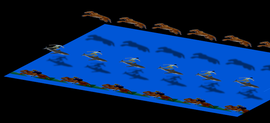

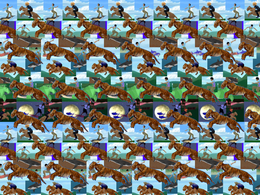













0 Response to "Pictures You Cant See the Same Way Again"
Enregistrer un commentaire